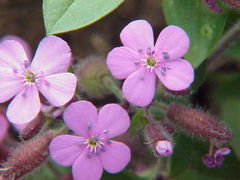- Saponaria
-
Saponaria 
Saponaria ocymoides Scientific classification Kingdom: Plantae (unranked): Angiosperms (unranked): Eudicots (unranked): Core eudicots Order: Caryophyllales Family: Caryophyllaceae Genus: Saponaria
L.Species About 20 species, including:
Saponaria bellidifolia
Saponaria caespitosa
Saponaria calabrica
Saponaria lutea
Saponaria ocymoides: Rock Soapwort
Saponaria officinalis
Saponaria pumila
Saponaria siculaSaponaria, also known as soapworts, is a genus of about 20 species of perennial herbs in the Caryophyllaceae, native to southern Europe and southwest Asia. The most familiar species in Europe is the Common Soapwort (S. officinalis), locally simply known as "the Soapwort". They grow to a height of 10-60 cm, with opposite leaves 1-6 cm long. The flowers are produced in tight clusters on the stem, 4-25 mm diameter, with five white, yellow, pink, or pale purple petals.
The genus is closely related to Lychnis and Silene, being distinguished from these by having only two (not three or five) styles in the flower.
Saponaria species are used as food plants by the larvae of some Lepidoptera species including the Lychnis and Coleophora saponariella (which feeds exclusively on Saponaria spp).
Cultivation and uses
Soapworts are cultivated for their attractive flowers; they grow freely in any soil and under most conditions. The crushed leaves or roots of S. officinalis have been used as a soap since the Renaissance. Museum conservators still use the soap made from its leaves and roots for cleaning delicate fabrics and it also makes a fine shampoo. Soapworts are also used in the food industry, especially in the making of halva (a sweet made using tahini and sugar or honey).
Categories:- Caryophyllaceae
- Caryophyllales stubs
Wikimedia Foundation. 2010.
